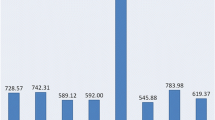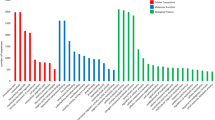Abstract
In the first large study of conifer expressed sequence tag-simple sequence repeats (EST-SSRs), two large conifer EST databases were characterized for EST-SSRs. One database was from “interior spruce” (white and Engelmann spruce in Southern British Columbia) and Sitka spruce, while the other was from loblolly pine. We found 475 and 629 unique EST-SSRs in loblolly pine and spruce, respectively. 3′ ESTs contained 14% more SSRs than 5′ EST reads in loblolly pine and 41% more in spruce. Conifer EST-SSRs differed conspicuously from angiosperm EST-SSRs in several aspects. EST-SSRs were considerably less frequent in conifers (one EST-SSR every ∼50 kb) than in angiosperms (one EST-SSR every ∼20 kb). Dinucleotide repeats were the most abundant repeat class in conifers, while in angiosperms, trinucleotides were most common. Finally, the AT motif was the dominant motif recovered in both conifer species, whereas AG was the most common dinucleotide repeat in angiosperms. Also, as these EST-SSRs in conifers could be developed into useful genetic markers, our work demonstrates the value of large-scale EST sequencing projects for in-silico approaches for marker development.



Similar content being viewed by others
References
Adams MD, Soares MB, Kerlavage AR, Fields C, Venter JC (1993) Rapid cDNA sequencing (expressed sequence tags) from a directionally cloned human infant brain cDNA library. Nat Genet 4:373–380
Akagi H, Yokozeki Y, Inagaki A, Fujimura T (1996) Microsatellite DNA markers for rice chromosomes. Theor Appl Genet 93:1071–1077
Amarasinghe V, Carlson JE (2002) The development of microsatellite markers for genetic analysis in Douglas-fir. Can J For Res 32:1904–1915
Ayers NM, McClung AM, Larkin PD, Bligh HFJ, Jones CA, Park WD (1997) Microsatellites and a single nucleotide polymorphism differentiate apparent amylose classes in an extended pedigree of US rice germplasm. Theor Appl Genet 94:773–781
Bérubé Y, Ritland C, Ritland K (2003) Isolation, characterization, and cross-species utility of microsatellites in yellow cedar (Chamaecyparis nootkatensis). Genome 46:353–361
Besnard G, Acheré V, Faivre Rampant P, Favres JM, Jeandroz S (2003) A set of markers developed from DNA sequence databanks in Picea (Pinaceae). Mol Ecol Notes 3:380–383
Cardle L, Ramsay L, Milbourne D, Macaulay M, Marshall D, Waugh R (2000) Computational and experimental characterization of physically clustered simple sequence repeats in plants. Genetics 156:847–854
Chagne D, Chaumeil P, Ramboer A, Collada C, Guevara A, Cervera MT, Vendramin GG, Garcia V, Frigerio JM, Echt C, Richardson T, Plomion C (2004) Cross-species transferability and mapping of genomic and cDNA SSRs in pines. Theor Appl Genet 2004:1204–1214
Chin ECL, Senior ML, Shu H, Smith JSC (1996) Maize simple repetitive DNA sequences: abundance and allele variation. Genome 39:866–873
Cordeiro G, Casu R, McIntyre C, Manners J, Henry RJ (2001) Microsatellite markers from sugarcane (Saccharum spp.) ESTs cross-transferable to erianthus and sorghum. Plant Sci 160:1115–1123
Echt CS, May-Marquardt P, Hseih M, Zahorchak R (1996) Characterization of microsatellite markers in eastern white pine. Genome 39:1102–1108
Gao L, Tang J, Li H, Jia J (2003) Analysis of microsatellites in major crops assessed by computational and experimental approaches. Mol Breed 12:245–261
Gupta PK, Balyan HS, Sharma PC, Ramesh B (1996) Microsatellites in plants: a new class of molecular markers. Curr Sci 70:45–54
Hancock JM (1995) The contribution of slippage-like processes to genome evolution. J Mol Evol 41:1038–1047
Hodgetts RB, Aleksiuk MA, Brown A, Clarke C, Macdonald E, Nadeem S, Khasa D (2001) Development of microsatellite markers for white spruce (Picea glauca) and related species. Theor Appl Genet 102:1252–1258
Huang X, Madan A (1999) CAP3: a DNA sequence assembly program. Genome Res 9:868–877
Jarne P, Lagoda PJL (1996) Microsatellites, from molecules to populations and back. Trends Ecol Evol 11:424–429
Jurka J, Pethiyagoda C (1995) Simple repetitive DNA sequences from primates: compilation and analysis. J Mol Evol 40:120–126
Kantety RV, La Rota M, Matthews DE, Sorrells ME (2002) Data mining for simple sequence repeats in expressed sequence tags from barley, maize, rice, sorghum, and wheat. Plant Mol Biol 48:501–510
Khajavi M, Tari AM, Patel NB, Tsuji K, Siwak DR, Meistrich ML, Terry NH, Ashizawa T (2001) ‘Mitotic drive’ of expanded CTG repeats in myotonic dystrophy type1 (DM1). Hum Mol Genet 10:855–863
Kirst M, Johnson A, Baucom C, Ulrich E, Hubbard C, Staggs R, Paule C, Retzel E, Whetten R, Sederoff R (2003) Apparent homology of expressed genes from wood-forming tissues of loblolly pine (Pinus taeda L.) with Arabidopsis thaliana. Proc Natl Acad Sci USA 100:7383–7388
Ledig FT, Hodgskiss PD, Krutovskii KV, Neale DB, Eguiluz-Piedra T (2004) Relationships among the spruces (Picea, Pinaceae) of southwestern North America. Syst Bot 29:275–295
Liewlaksaneeyanawin C, Ritland CE, El-Kassaby YA, Ritland K (2004) Single-copy, species-transferable microsatellite markers developed from loblolly pine ESTs. Theor Appl Genet 109:361–369
Metzgar D, Bytof J, Wills C (2000) Selection against frameshift mutations limits microsatellite expansion in coding DNA. Genome Res 10:72–80
Morgante M, Olivieri AM (1993) PCR-amplified microsatellites as markers in plant genetics. Plant J 3:175–182
Morgante M, Hanafrey M, Powell W (2002) Microsatellites are preferentially associated with nonrepetitive DNA in plant genomes. Nat Genet 30:194–200
Pfeiffer A, Olivieri AM, Morgante M (1997) Identification and characterization of microsatellites in Norway spruce (Picea abies K.). Genome 40:411–419
Powell W, Machray GC, Provan J (1996) Polymorphisms revealed by simple sequence repeats. Trends Plant Sci 1:215–222
Rajora OP, Rahman MH, Dayanandan S, Mosseler A (2000) Isolation, characterization, inheritance and linkage of microsatellite DNA markers in white spruce (Picea glauca) and their usefulness in other spruce species. Mol Gen Genet 264:871–882
Richards RI, Sutherland GR (1992) Dynamic mutations: a new class of mutations causing human disease. Cell 70:709–712
Rungis D, Bérubé Y, Zhuang J, Ralph S, Ritland CE, Ellis BE, Douglas C, Bohlmann J, Ritland K (2004) Robust simple sequence repeat (SSR) markers for spruce (Picea spp.) from expressed sequence tags (ESTs). Theor Appl Genet 109:1283–1294
Samadi S, Artiguebielle E, Estoup A, Pointier JP, Silvain JF, Heller J, Cariou ML, Jarne P (1998) Density and variability of dinucleotide microsatellites in the parthenogenetic polyploid snail Melanoides tuberculata. Mol Ecol 7:1233–1236
Schlötterer C, Tautz D (1992) Slippage synthesis of simple sequence DNA. Nucleic Acids Res 20:211–215
Scott KD, Eggler P, Seaton G, Rossetto M, Ablett EM, Lee LS, Henry RJ (2000) Analysis of SSRs derived from grape ESTs. Theor Appl Genet 100:723–726
Scotti I, Paglia G, Morgante M (2002a) Trinucleotide microsatellites in Norway spruce (Picea abies Karst.): their features and the development of molecular markers. Theor Appl Genet 106:40–50
Scotti I, Magni F, Paglia G, Morgante M (2002b) Efficient development of dinucleotide microsatellite markers in Norway spruce (Picea abies Karst.) through dot-blot selection. Theor Appl Genet 104:1035–1041
Soranzo N, Provan J, Powell W (1998) Characterization of microsatellite loci in Pinus sylvestris L. Mol Ecol 7:1260–1261
Tautz D, Renz M (1984) Simple sequence repeats are ubiquitous repetitive components of eukaryotic genomes. Nucleic Acids Res 12:4127–4138
Temnykh S, DeClerck G, Lukashova A, Lipovich L, Cartinhour S, McCouch S (2001) Computational and experimental analysis of microsatellites in rice (Oryza sativa L.): frequency, length variation, transposon associations, and genetic marker potential. Genome Res 11:1441–1452
The Huntington’s Disease Collaborative Research Group (1993) A novel gene containing a trinucleotide repeat that is expanded and unstable on Huntington’s disease chromosomes. Cell 72:971–983
Tóth G, Gáspári Z, Jurka J (2000) Microsatellites in different eukaryotic genomes: survey and analysis. Genome Res 10:967–981
van de Ven WTG, McNicol RJ (1996) Microsatellites as DNA markers in Sitka spruce. Theor Appl Genet 93:613–617
Varshney RK, Thiel T, Stein N, Langridge P, Graner A (2002) In silico analysis on frequency and distribution of microsatellites in ESTs of some cereal species. Cell Mol Biol Lett 7:537–546
Wright JW (1955) Species crossability in spruce in relation to distribution and taxonomy. For Sci 1:319–349
Website references
ftp://ftp.ncbi.nih.gov/repository/dbEST/; NCBI’s EST database ftp site
http://www.genetics.forestry.ubc.ca/ritland/programs.html; Kermit Ritland’s repository of population genetics/bioinformatics programs. The Java program SSRFinder version 2 can be found here
Acknowledgments
This research was made possible through funding by Genome Canada and the Province of British Columbia (to J.B. and K.R.) through the Genome BC Forestry Genome Project. The authors would also like to acknowledge the support of the Vancouver Genome Sciences Centre for EST sequencing and database development.
Author information
Authors and Affiliations
Corresponding author
Additional information
Communicated by O. Savolainen
Rights and permissions
About this article
Cite this article
Bérubé, Y., Zhuang, J., Rungis, D. et al. Characterization of EST-SSRs in loblolly pine and spruce. Tree Genetics & Genomes 3, 251–259 (2007). https://doi.org/10.1007/s11295-006-0061-1
Received:
Accepted:
Published:
Issue Date:
DOI: https://doi.org/10.1007/s11295-006-0061-1




